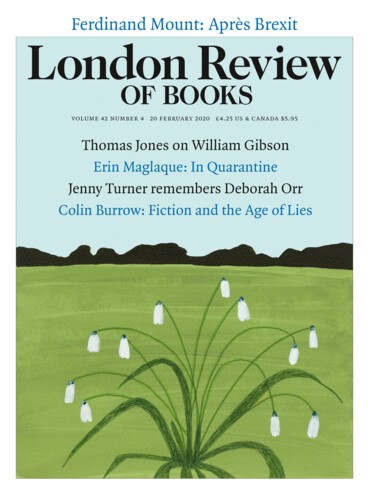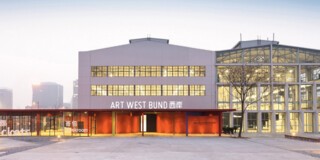The West Bund quarter of Shanghai runs along a bend of the Huangpu river, about eight kilometres south of the city’s downtown. There were once docks here, with a large facility for mixing concrete. Planes landed at Lunghua airfield. As industry moved out from the city, the riverside became available to developers. West Bund is now Shanghai’s art quarter, and an annual art fair is housed in one of the old airport hangars. Commercial galleries from the West, many from London, compete with their Chinese counterparts to attract collectors. The stands are dominated by big, flashy canvases – painting is the preferred medium. Dealers try to broker some kind of understanding between what Chinese collectors might want – large, gestural, semi-abstract paintings – and other things the gallery has to offer. A stone circle by Richard Long; an early To the Studios painting by Frank Auerbach. It’s difficult to say what these might mean in a Chinese context.
This internationalism is new in China, according to the fair’s director, the painter Zhou Tiehai. It seems to indicate an openness to liberal market values, if not to Western contemporary art. Along the riverfront are several new galleries. Tank Shanghai, which opened last year, is spread across five disused fuel tanks on the old airfield. When I visited, the main exhibition was an overview of contemporary art from Belgium. On the site of a coal unloading wharf just downriver is the Long Museum West Bund, which opened in 2014: a vast, cantilevered, poured-concrete building, more like transport infrastructure than museum architecture. Its vast galleries burrow underground, a cavernous parking lot for Chinese art.
The newest addition, the West Bund Museum, opened in November. For the next five years it will show changing displays from the collection of the Centre Pompidou, arranged around three themes: modern, postwar and new media art (including video works from the 1970s, so not entirely new). The ‘modern’ story is told conventionally, beginning with Picasso’s high Cubist Man with a Guitar from 1910, on through abstraction to gestural painting, colour field painting and Op Art. The postwar section takes in Joseph Beuys, Land Art, photographic painting and installation, ending on Bon Voyage (2004) by the Chinese artist Cai Guo-Qiang: an aeroplane made of wicker and bamboo in which are lodged thousands of objects confiscated at airport security. Given the ascendancy of contemporary Chinese art it seems an appropriate point for the show to end on.
What do Chinese visitors make of an austere Picasso or Duchamp’s readymade bicycle wheel mounted on a stool? Modern European art history is not widely taught in China, Zhou tells me. In the catalogue for a recent Picasso exhibition at the Ullens Centre for Contemporary Art in Beijing, the art historian Wu Xueshan writes that in the 1930s Picasso was known in China as the ‘Lenin of painting’, because of his blue period paintings of ordinary people. Chinese artists went to Paris to study his work and when he joined the French Communist Party in 1944 his reputation seemed assured. Later, he was associated with the innocuous images of doves he made as publicity symbols for the World Peace Council. Yet there were no Picassos in public hands in China until four late paintings were donated to Beijing’s National Art Museum in 1996. Sporadic exhibitions in the decades before and after were hardly enough to build up any familiarity with Picasso or with Western modernism generally.
The West Bund Museum is intended to change that: in the planning for almost two decades, it is undoubtedly a project of soft diplomacy, the Pompidou’s cultural largesse disseminating the official Western story. But the encounter between China and the West goes both ways: in this new context, works from the modernist canon open themselves up to fresh interpretations. In Shanghai, Man with a Guitar appears not so far removed from traditional Chinese painting: the uniform brown surface, delicately broken by dabs and washes; the character of the brushmarks, which convey as much as, if not more than, the elusive, unfinished subject matter. The incorporation of words into Cubist paintings and collages has a distant ancestor in the inscriptions and commentaries on classical Chinese scrolls and album leaves.
But the new media galleries are the most arresting. Mona Hatoum’s film Corps d’étranger (1994), projected onto the floor of a narrow cylindrical chamber, shows an endoscopic interrogation of Hatoum’s skin and orifices to a soundtrack of breath and pulsing blood. For Mapping the Studio II (2001), Bruce Nauman used closed-circuit cameras to record his studio at night. Over six hours, the stillness is interrupted by a cat, a moth, a rat and then Nauman himself, in pyjamas and slippers, changing the camera’s battery. Zhang Peili’s Uncertain Pleasures (1996) consists of video monitors placed on the floor, surrounded by wires and switches, each showing a hand scratching some part of the body. For her film Underground (2002), Cui Xiuwen filmed a woman wearing a red coat on the Beijing metro, tracking her intimate gestures and expressions. Peter Campus used a surveillance camera and CCTV for his 1972 installation Interface, which is re-created here in a darkened room. Two ghostly images appear on a glass screen: your own real but faint reflection, and a brighter, better-defined video image. The two line up only when you stand dead centre.
It’s hard not to think that works engaging with video surveillance, the virtual world, techno-authoritarianism and mass surveillance will speak to Chinese visitors in a way that Cubism may not. Outside the museum, the pedestrian crossing consoles use facial recognition to identify and publicly shame jaywalkers: their photos flash up on a screen, along with their personal details. The Xuhui district, which surrounds the art quarter, has been designated an ‘Intelligence Valley’, a global centre for the development of AI and Big Data technology. Trying to make some kind of connection between AI and art appears to be part of the plan behind the West Bund development – although what this will mean, exactly, remains unclear. The new buildings along the riverfront are dominated by the gleaming, just completed AI Tower, soon to be occupied by Huawei, Alibaba and Microsoft Research Asia; it dwarfs the surrounding museums. At night, digital images ripple over the glass façade, making the air pulse with artificial light.
Send Letters To:
The Editor
London Review of Books,
28 Little Russell Street
London, WC1A 2HN
letters@lrb.co.uk
Please include name, address, and a telephone number.


